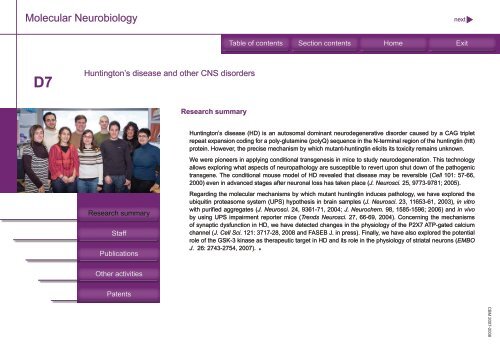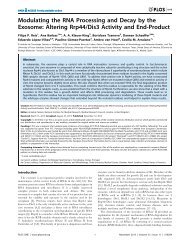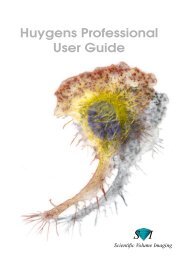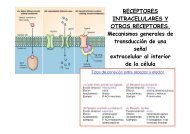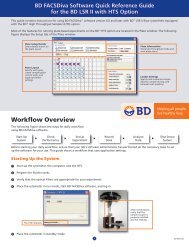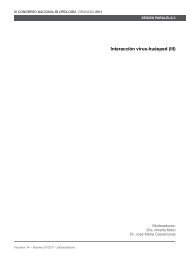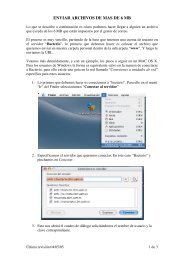Molecular Neurobiology - Universidad Autónoma de Madrid
Molecular Neurobiology - Universidad Autónoma de Madrid
Molecular Neurobiology - Universidad Autónoma de Madrid
You also want an ePaper? Increase the reach of your titles
YUMPU automatically turns print PDFs into web optimized ePapers that Google loves.
<strong>Molecular</strong> <strong>Neurobiology</strong><br />
previous next<br />
Table of contents Section contents Home Exit<br />
D7<br />
Huntington’s disease and other CNS disor<strong>de</strong>rs<br />
Research summary<br />
Huntington’s disease (HD) is an autosomal dominant neuro<strong>de</strong>generative disor<strong>de</strong>r caused by a CAG triplet<br />
repeat expansion coding for a poly-glutamine (polyQ) sequence in the N-terminal region of the huntingtin (htt)<br />
protein. However, the precise mechanism by which mutant-huntingtin elicits its toxicity remains unknown.<br />
We were pioneers in applying conditional transgenesis in mice to study neuro<strong>de</strong>generation. This technology<br />
allows exploring what aspects of neuropathology are susceptible to revert upon shut down of the pathogenic<br />
transgene. The conditional mouse mo<strong>de</strong>l of HD revealed that disease may be reversible (Cell 101: 57-66,<br />
2000) even in advanced stages after neuronal loss has taken place (J. Neurosci. 25, 9773-9781; 2005).<br />
Research summary<br />
Staff<br />
Publications<br />
Regarding the molecular mechanisms by which mutant huntingtin induces pathology, we have explored the<br />
ubiquitin proteasome system (UPS) hypothesis in brain samples (J. Neurosci. 23, 11653-61, 2003), in vitro<br />
with purified aggregates (J. Neurosci. 24, 9361-71, 2004; J. Neurochem. 98, 1585-1596; 2006) and in vivo<br />
by using UPS impairment reporter mice (Trends Neurosci. 27, 66-69, 2004). Concerning the mechanisms<br />
of synaptic dysfunction in HD, we have <strong>de</strong>tected changes in the physiology of the P2X7 ATP-gated calcium<br />
channel (J. Cell Sci. 121: 3717-28, 2008 and FASEB J. in press). Finally, we have also explored the potential<br />
role of the GSK-3 kinase as therapeutic target in HD and its role in the physiology of striatal neurons (EMBO<br />
J. 26: 2743-2754, 2007).<br />
Other activities<br />
Patents<br />
CBM 2007-2008


